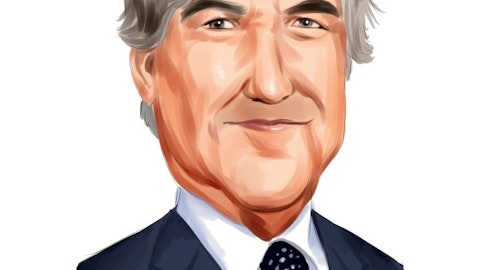Deluxe Corporation (NYSE:DLX) Q4 2022 Earnings Call Transcript February 2, 2023
Operator: Ladies and gentlemen, thank you for standing by, and welcome to the Deluxe Fourth Quarter and Full Year 2022 Earnings Conference Call. At this time, all participants are in a listen-only mode and today’s call is being recorded. We will begin by opening remarks and introductions. At this time, I would like to turn the conference over to your host, Vice President of Investor Relations, Tom Marabito. Please go ahead.
Thomas Morabito: Thank you, operator and welcome to the Deluxe fourth quarter and full year 2022 earnings call. Joining me on today’s call is Barry McCarthy, our President and Chief Executive Officer; and Chip Zint, our Chief Financial Officer. At the end of today’s prepared remarks, we will take questions. Before we begin and as seen on this slide, I’d like to remind everyone that comments made today regarding management’s intentions, projections, financial estimates or expectations about the company’s future strategy or performance are forward-looking in nature as defined in the Private Securities Litigation Reform Act of 1995. Additional information about factors that may cause our actual results to differ from projections is set forth in the press release we furnished today and our Form 10-K for the year ended December 31, 2021, and in other company SEC filings.
On the call today, we will discuss non-GAAP financial measures, including comparable adjusted revenue, adjusted and comparable adjusted EBITDA, adjusted and comparable adjusted EBITDA margin, adjusted EPS and free cash flow. To streamline discussion of our ongoing business operations, today and going forward we will discuss both revenue and EBITDA on a comparable adjusted basis which will exclude the inconsistency caused by acquisitions or divestitures in the prior periods. For purposes of full year 2022 this will exclude the partial year impact of First American and impact of the divestitures done throughout the year. In our press release, our presentation, and our filings with the SEC, you will find additional disclosures regarding the non-GAAP measures, including reconciliations of these measures to the most comparable measures under U.S. GAAP.
Also on the presentation we are providing additional reconciliations of GAAP EPS to adjusted EPS, which should help with your modeling. Now I’ll turn it over to Barry.
Barry C. McCarthy: Thanks, Tom and good morning, everyone. Deluxe delivered strong results for both the fourth quarter and full year 2022, further proving we have become a payments and data company. As I expect payments — will become our largest segment by revenue during the first half of 2023. This will be a key milestone in the company’s history. Before reviewing the results, let me take a moment to reflect on what was another strong year for Deluxe. Four key highlights from the year include; first, reporting our second consecutive year of sales driven revenue growth, an achievement not seen over a decade, showing the strength of our One Deluxe model. Second, the accelerating success of our payments and data business. In payments, First American continues to perform well in its second year as part of Deluxe and we’re expanding blended margins across the segments.
In the data business, we recorded record revenue. Third, strong performance in our print businesses Promo and Check. Promo strongly rebounded after the impacts of COVID and supply chain disruptions and Check has delivered its strongest top line performance in over 10 years. This performance shows the durability of demand for these solutions. Fourth, our ERP implementation went live with its last major release earlier this week. This key milestone marks the completion of our major corporate infrastructure modernization. We also just announced the exit of our North American web hosting business, which was a non-strategic business line allowing us to further focus on payments and data. Chip will provide more details on the transaction. We’ve also changed the name of our Cloud Solutions segment to Data Solutions to better reflect the more focused operations of that business.
Let me also take a moment to thank my fellow Deluxers for another strong year, for their endless dedication to our customers, and for their continued commitment to making Deluxe a payments and data company. The sales team gathered last week for our sales kickoff, and the energy and excitement about 2023 was palpable. Now on to the results. For full year 2022, comparable adjusted revenue was $2.1 billion, up 5.2% year-over-year. Reported revenue increased 10.7% above our guided range. Once again, this is our second consecutive year of sales driven revenue growth. This is a key milestone. We continue to demonstrate the success of our One Deluxe model. For 2022, all four segments demonstrated comparable adjusted revenue growth, an accomplishment, which has not been seen in a very long time.
So long ago it’s outside the range of available data. Total adjusted EBITDA dollars increased 2.5% from 2021 and comparable adjusted EBITDA was down 4%. Going forward, we remain focused on driving growth in revenue, adjusted EBITDA, and free cash flow for the long term. All of our actions drive towards these goals, which in turn we believe will drive greater shareholder returns. Moving on to some segment revenue highlights. For the full year on a comparable adjusted basis, payments revenue grew 4.7% and adjusted EBITDA dollars grew 8.3% with margins expanding 70 basis points from 2021. Merchant services revenue increased 4.4% on a comparable adjusted basis, in line with our longer-term expectations of mid-single-digit growth. The rest of payments, which includes our receivables and payables business, grew nearly 5% with growth across our product lines, primarily in digital payments and treasury management.
Our pipeline continues to grow and we continue to gain wallet share from existing customers as we remain on track for payments to be our largest revenue segment in the first half of the year. As I said earlier this will be another key milestone for Deluxe as we’ve now become a payments and data company. Data had a strong year, growing comparable adjusted revenue 8.6% year-over-year as we continue to expand the business into non-interest rate sensitive verticals. Promo had a solid year on the top line, improving comparable adjusted revenue 6.1%. We were also pleased with the improvement in margins as the year progressed, which Chip will detail later. Finally, our Check business improved 3.7% year-over-year, an incredible accomplishment. However, we are expecting this segment to return to traditional secular decline rates this year as we’ve now lapped the growth from key wins in 2021.
As discussed on prior calls, our strategic investments in new Print-on-Demand technology will help us manage costs to match volumes, allowing us to maintain our strong margin rate in this segment as we return to normal secular declines. We’re about halfway through the implementation of this new technology. We’re proud of both our fourth quarter and full year results which highlight our progress. Deluxe is now a fundamentally different company than what we were just a few years ago with payments, a strong secular growth business soon to be our largest revenue segment. And we’ve proven our One Deluxe model delivers top line growth. This was achieved while simultaneously modernizing the company’s entire infrastructure, navigating COVID and inflation, executing significant portfolio optimization, and more.
Now I’ll turn it over to Chip who will provide more details on our financial performance.
Chip Zint: Thank you, Barry and good morning, everyone. Before we review the results for the quarter, I’d like to elaborate on the pending sale of our North American web hosting business. Last year we sold our Australian web hosting operations and upon completion of the latest transaction we will have completely exited the hosting business. As a reminder, this business has historically been largely a white label service offered through telecom partners which did not allow for material cross selling opportunities and did not fit within our overall portfolio. This pending deal also includes our logo business. For the trailing 12 months these businesses generated approximately $66 million in revenue with adjusted EBITDA margins in the mid to high 30% range.
The web hosting business was previously fully impaired due to its capital intensive nature and recurring revenue declines. This was further evidenced in the fourth quarter where revenue declined 8% year-over-year. 2023 revenue will be impacted by approximately $45 million and adjusted EBITDA and free cash flow each will be impacted by approximately $20 million. These impacts are included in our guidance, which I’ll discuss in a moment and mostly affect our data segment with a very small impact to the promo segment. I know there have been many changes to the portfolio recently, but they reflect a methodical effort to simplify and focus the business. For more information about the business exits and impact to guidance, please refer to the reconciliations in our press release and presentation.
Additional details of the transaction can also be found in our recently filed Form 8K with the SEC. Now let’s go through the consolidated highlights for the quarter and year before moving on to the segments. For the fourth quarter, total comparable adjusted revenue improved 1.2% to $564 million. On a reported basis, revenue declined 1.2% year-over-year. We reported fourth quarter GAAP net income of $19 million or $0.44 per diluted share, up from $14 million or $0.32 per share in the fourth quarter of 2021. Adjusted EBITDA came in $112 million, down $3 million or 2.8% on a comparable adjusted basis from last year. Improvements in payments, data and promo were offset by checks and employee benefit costs on the corporate segment. Comparable adjusted EBITDA margins were 19.9% and in line with our expectations.

Photo by Anthony DELANOIX on Unsplash
Fourth quarter adjusted diluted EPS came at $1.04, down from $1.26 in last year’s fourth quarter. This decrease was primarily driven by interest expense. As a reminder, nearly 60% of our debt is fixed rate, which should help insulate the company from future rate hikes. For the full year, on a reported basis, we posted total revenue of $2.24 billion, up 10.7% year-over-year and above our guided range. As Barry mentioned, comparable adjusted revenue increased 5.2% year-over-year. We reported full year GAAP net income of $65 million or $1.50 per share for the year, up from $63 million or $1.45 per share in 2021. Full year adjusted EBITDA was $418 million up $10 million or 2.5% as reported from last year. Adjusted EBITDA margins were 18.7%, down from last year’s 20.2% due to business mix and the impact of pass through price increases to offset inflation.
On a comparable adjusted basis, EBITDA dollars declined 4% for the year and EBITDA margins were 18.5% down from 20.3% last year. Full year adjusted EPS came in at $4.08, down from $4.88 in 2021, primarily due to higher interest expense, depreciation, and amortization. Now turning to our segment details, starting with our growth businesses, payments and data. Payments grew fourth quarter revenue 2.5% year-over-year to $171 million, with merchant services growing 3.3% year-over-year. As we indicated on the last call, we anticipated slower growth for a few quarters as all of payments was up against tough year-over-year comparisons. We do, however, expect growth rates to improve as the year progresses. Payments adjusted EBITDA margins were 21.6%, up from last year’s 20.6%, largely driven by operating leverage in our treasury and management business.
For the year, payments grew revenue 33% year-over-year to $679 million, driven by the acquisition of First American and sales driven growth for standalone Deluxe. For the year and including First American adjusted EBITDA increased 36.9% and adjusted EBITDA margins were 21.3%, up 60 basis points. On a comparable adjusted basis for the year, payments revenue increased 4.7%, EBITDA increased 8.3%, and EBITDA margins were 21.4% up from 20.7%. For 2023 we expect to see mid-single-digit revenue growth and adjusted EBITDA margins in the low to mid 20% range. Data’s adjusted EBITDA margin in the quarter increased 340 basis points year-over-year to 27.6%, which again relates to timing as well as operating leverage from strong DDM volume. On a comparable adjusted basis, EBITDA margins improved 300 basis points.
For the year, the Data segment comparable adjusted revenue increased 8.6% year-over-year to $268 million. On a reported basis, Data grew 2% for the year. For 2022, Data’s adjusted EBITDA margins declined 130 basis points versus prior year to 25.5%, driven by business mix and the investments in our Data platform. On a comparable adjusted basis, EBITDA margins declined 170 basis points. For 2023, we expect to see low single-digit revenue growth on a comparable adjusted basis. We also expect to see comparable adjusted EBITDA margins in the low 20% range. Turning now to our Print businesses, Promo and Checks. Promo’s fourth quarter revenue was $154 million, up 3.1% on a comparable adjusted basis, driven by new sales wins and pricing actions. On a reported basis, revenue declined 1.5% year-over-year.
Promo’s adjusted EBITDA margins increased 100 basis points year-over-year to 19.3%, but improved nearly 600 basis points sequentially as we benefited from continued pricing actions, stable supply conditions, and normal seasonal upticks. On a comparable adjusted basis, EBITDA margins improved 50 basis points from the fourth quarter of 2021. For the year, Promo’s revenue was $563 million, up 6.1% year-over-year on a comparable adjusted basis or 3% on a reported basis. Adjusted EBITDA margins for the year were 14.1% and down 150 basis points and on a comparable adjusted basis were down 190 basis points. For 2023, we expect to see low single-digit comparable adjusted revenue growth and adjusted EBITDA margins in the mid-teens. Check’s fourth quarter revenue decreased 4.6% from last year to $176 million as the business returned to expected secular declines with Q4 results now lapping all the major new customer wins from 2021.
Fourth quarter adjusted EBITDA margins were 42.5%, down 270 basis points year-over-year as we experienced off-cycle supplier price increases for both materials and logistics inputs, some of which are temporary seasonal base surcharges. We have factored these and future expected increases into our 2023 customer price increases. As a result, we believe the margin rate will improve in Q1. Check’s full year 2022 revenue was $729 million, up 3.7% year-over-year and adjusted EBITDA margins were 44%, down 210 basis points, but consistent with our long-term expectations of mid-40% margins. For 2023, we are expecting mid-single-digit revenue declines and adjusted EBITDA margins in the mid-40% range. As Barry mentioned, our print-on-demand technology will help maintain margins, and we are about halfway through the implementation.
Turning now to our balance sheet and cash flow. We ended the year with a net debt level of $1.6 billion, down from $1.64 billion last year, demonstrating our continued commitment to pay down debt. Our net debt-to-adjusted EBITDA ratio was 3.8 times at the end of the year, improving from 4 times a year ago. Our long-term strategic target remains approximately 3 times. Free cash flow, defined as cash provided by operating activities less capital expenditures, was $37 million in the quarter, up from $34 million in the fourth quarter of 2021 due to improved working capital and lower cloud computing arrangement or CCA spend, partially offset by higher interest payments. This was also a sequential improvement from the third quarter. First quarter 2023 free cash flow was expected to be negative as it will be impacted by incremental interest expense, onetime expenses from our ERP implementation, and annual employee compensation payments, but should improve as the year progresses.
For the year, free cash flow was $87 million, down from $102 million in 2021 due to higher interest payments, cash taxes, and working capital. Our Board approved a regular quarterly dividend of $0.30 per share on all outstanding shares. The dividend will be payable on March 6, 2023, to all shareholders of record as of market closing on February 21, 2023. We are focused on taking a balanced approach to capital allocation and as a reminder, our capital allocation priorities are to responsibly invest in growth, pay our dividend, reduce debt, and return value to our shareholders. Turning now to guidance. Today, we are providing our expectations for 2023, keeping in mind all figures are approximate and reflect the expected impact of the web hosting and logo divestiture.
Revenue of $2.145 billion to $2.21 billion, adjusted EBITDA of $390 million to $405 million, adjusted EPS of $2.90 to $3.25, and free cash flow of $80 million to $100 million. To be clear, on a comparable adjusted basis, 2023 revenue represents a range of negative 1% to positive 2% growth. The comparable adjusted EBITDA range represents negative 2% to positive 2% growth. To further clarify, EPS is expected to decline year-over-year due to the full year impact of rising interest rates, incremental depreciation and amortization and an estimated $0.25 impact from the announced divestiture. However, factoring in the impact of the divestiture, the free cash flow guide is an increase year-over-year on a comparable adjusted basis. Also, in order to assist with your modeling, our guidance assumes the following; interest expense of $120 million to $125 million; an adjusted tax rate of 26%; depreciation and amortization of $170 million, of which acquisition amortization is approximately $75 million; an average outstanding share count of 43.7 million shares, and capital expenditures of approximately $100 million.
This guidance is subject to, among other things, prevailing macroeconomic conditions, including interest rates, labor supply issues, inflation, and the impact of other divestitures. To summarize, we are pleased with the fourth quarter and full year 2022 results. Our sales pipeline continues to expand with new customers, and we continue to see increased growth from our existing customer base. We look forward to continuing the momentum in 2023, a year which we expect to be highlighted by continued revenue growth, increased operational efficiencies, and increased free cash flow. Operator, we are now ready to take questions.
See also 10 Most Undervalued Solar Stocks to Buy and 12 Most Undervalued Travel Stocks To Buy .
Q&A Session
Follow Carter Securities Corp
Follow Carter Securities Corp
Operator: . Your first question comes from the line of Lance Vitanza from Cowen. Your line is open.
Lance Vitanza: Hi guys, thanks very much for taking the questions. A lot to unpack here. But let me start with the web hosting and logo divestiture. Did you call out the EBITDA margin on the asset sale?
Barry C. McCarthy: We did. We said that it was mid to high 30s. And as you know, Lance that is a business that was a consumer of capital, and it was in decline. We also mentioned that in the fourth quarter revenue in that segment declined 8%.
Lance Vitanza: So right. So $665 million of revenue and kind of like $25-ish million of EBITDA, something in that range, or in that general vicinity. And I guess — and that was for the trailing 12 months. Where I’m going with this, Barry, is I’m thinking about your adjusted EBITDA guidance of $390 million to $405 million, which right on the face of it, it looks like it’s down versus the $418 million that you printed this year or for 2022. But if we add the $25 million-ish, right, from the asset sales, then we’re sort of — we’re getting to that slight EBITDA positive that you talked about in the 8-K filing, is that sort of the right way to think about it?
Chip Zint: This is Chip. So as you have time to digest this, you’ll see at the back of our earnings release and slides, we have provided some information that will reconcile that for you, especially on the guidance side. But your back-of-a-napkin math is roughly right around $25 million of EBITDA for a full year. We are, of course, modeling into our guidance only three quarters of impact, that’s where we get the roughly $45 million revenue impact and approximately $20 million EBITDA impact that I just referred to on the call. But all of those things plus the impact of last year’s exits rolling forward are reconciled in the back. And that’s why we thought it was important to move just favorable adjusted dynamics so that it can be much more transparent on how the business is doing on an apples-to-apples basis.
Lance Vitanza: Okay. Great. Maybe moving on to the Data segment that continues. You mentioned during the call, continued diversification into noninterest rate-sensitive verticals. And I’m wondering how much of the data segment, again, on a go-forward basis, how much of that Data segment currently is in noninterest rate-sensitive verticals?
Barry C. McCarthy: Lance, I don’t think we’ve ever provided sort of the sources of revenue at that level. But the reason that business continues to perform well in a period of rising interest rates, I think, is because those noninterest rate sectors or categories are experiencing really attractive growth rates that are more than offsetting things that were highly sensitive like mortgage. And if you look back in our history, you can see previous interest rate cycles like this, that business was pretty significantly impacted and we’re actually showing growth. And so I think that gives you a good sort of direction that it’s increasingly about noninterest rate-sensitive categories.
Lance Vitanza: Is it possible to talk a little bit about which of those noninterest rate-sensitive verticals present the most obvious or most compelling opportunities for Deluxe? And are there any examples of recent wins to call out anything like along those lines?





